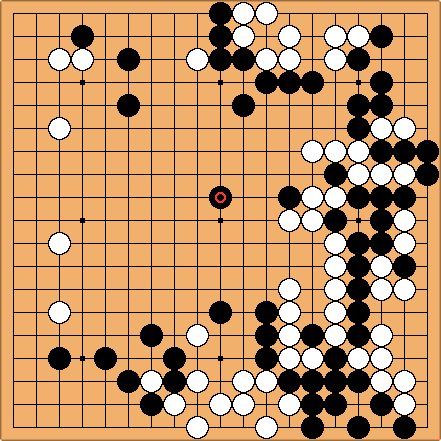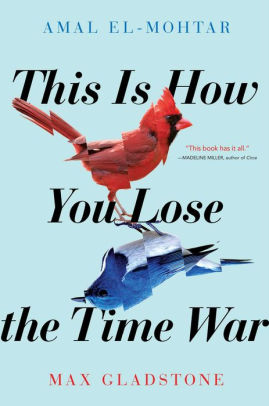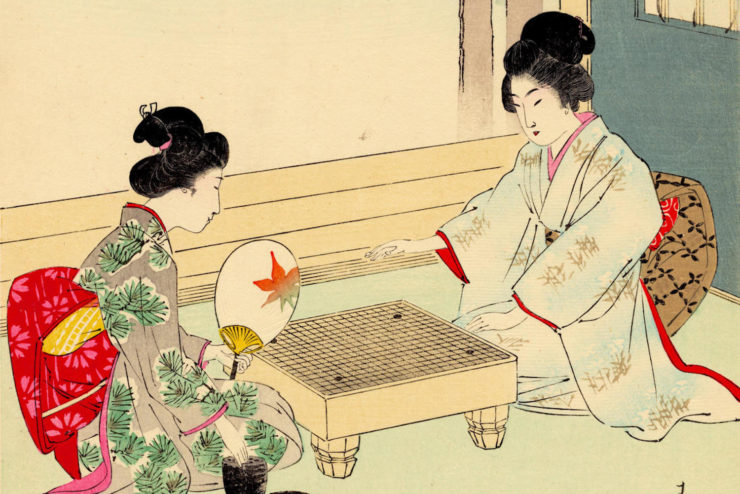Much can be written about Amal El-Mohtar and Max Gladstone’s powerhouse novella, This Is How You Lose the Time War—about its razor-sharp prose, the stunning romance at its center, the way it privileges language and art as the tools that connect us across time and space. There’s a reason it recently won a Hugo award: this little novella packs a punch, and it hits hard. And it’s about a war, after all, so why not call in these violent metaphors to describe its success?
But Time War offers an alternative set of figurative language in its pages: not of violence and war, but of strategy games. Blue and Red aren’t just soldiers in battles, but players of games; they aren’t just executing war tactics, but “plays” and “hands.” Poker, tic-tac-toe, and chess are the tools in El-Mohtar and Gladstone’s arsenal, used to lay out the graceful and intricate machinations of a relationship born and nurtured out of rivalry and matched wits. One strategy game metaphor stands above the rest, though: Go (or: Igo, Baduk, Weiqi). A board game that dates back to the 4th century BC, Go stands apart even from its typical western counterpart of chess. Its strategy is collaborative and aesthetic, complex and changing over time. A perfect metaphor, in other words, for lovers meeting across a time-warped battlefield.
I don’t mean to belabor a piece of figurative language here. Go is called upon directly four times in Time War, by my estimation—a lot for a 200-page book, though still matched by other similes, comparisons, and allusions (Chatterton; poker; planted seeds; how this novella contains so much in so few words is beyond me). Combined with the authors’ constant references to games and play in general, though, the subject of Go grows in its usage, becomes a map by which to read what this remarkable little book is “about.”
So what is Go, exactly? Two players approach a basic, empty 19×19 grid and, in turns, begin to fill the board with competing black and white stones in a bid for territory. Each intersecting line is a piece of territory that can be surrounded; stones may surround and capture one another, but strategy more often than not relies on the dance and interplay between stones—sometimes touching, sometimes lying latent. It’s a simple enough premise, but one with endlessly complex iterations (it wasn’t until 2015 that a computer successfully defeated a professional player). According to Time War’s Blue, Go is a game wherein “outcomes [are] determined from the first move, endlessly iterated until the split where we fork off into unstable, chaotic possibility.” According to Red, it’s a strategic struggle wherein “you place each stone expecting it may do many things. A strike is also a block is also a different strike. A confession is also a dare is also a compulsion.”

Go, in the context of Time War, is time travel. It isn’t just the 19×19 coordinate options that lend the game its complexity (though the 3^361×0.012 = 2.1×10^170 potential moves don’t hurt), but the positionality, the contingency. With the meaning of each move changing over time, its narrative is not linear. Where most strategy games unfold with the grace of a plotted story, Go moves map like a messy history, where meaning is made only in hindsight, where brilliance can turn obsolete and banality groundbreaking. In Time War, Blue and Red’s relationship is built on this muddying of linearity—from letters that only reveal themselves at a particular moment in time, to their encounters with one another out-of-synch. It’s part of what makes the story itself so unique, obviously, and it’s also what makes the romance so emotionally rich. These women, these players, find ways to communicate over the greatest possible obstacle—time—and are able to see one another in a way no one else does because of it. They share not just a moment in time, but a network of moments.
Red and Blue’s love is at the heart of this Go metaphor, in fact. It is, after all, a game that can be read collaboratively rather than combatively. One of the more famous depictions of Go, the manga/anime series Hikaru no Go, depicts a similar rivalry, this time between two aspiring professional Go players. Its ending, in which the protagonist returns to the game after quitting for some time, resounds with an outsider observing the rivals, saying that the secret to playing the best possible game—to obtaining the “kami no itte” or “hand of god”—is to remember that “it takes two people to play Go.” In the end, it is a story not about overcoming someone, but of finding them, of growing and becoming greater through your rivalry.
Buy the Book


This Is How You Lose The Time War
The pleasure of pitting your mind against an equal, of finding your “other” is part and parcel of Time War’s grand romance. Rather than competing for mutually-assured destruction, Red and Blue embark on a mutual journey of creation, weaving words into penetrating and pleasurable points of connection. “I wanted to be seen,” writes Red in one of her letters, full of an intangible yearning that is unrecognizable to her peers or comrades. Finding Blue, wooing her, knowing her is not an overcoming—it’s a recognition. It’s an act of reading and interpretation. It’s an art.
The American Go Association itself describes Go as “about building, not destroying… As you gain playing experience and the game begins to make sense, stones form meaningful, wondrous patterns, in the same way that letters and spaces can form a beautiful poem.” It is an aesthetic game as much as a game of strategy, and each game is a work of art forged by a partnership of players. Time War simply takes this collaborative artistic strategy to the next level, allowing the rivals on either side of the board to acknowledge the immense affinity between them, to stop using their tactics and wits at the request of their superior officers and instead play a game of their own design.
This is How You Lose the Time War may pack a punch—to return to our metaphors of violence—but it also paints a picture. By using the image of Go—contingent, collaborative, aesthetic—it creates for its readers an image of possibility. It invites us to see “make love, not war” as not simply a platitude, but instead as a tactic in a long, complex game with simple rules.
Em Nordling is a writer & PhD student in Atlanta, GA. They were president of their high school Go club and are, objectively, a terrible player.










